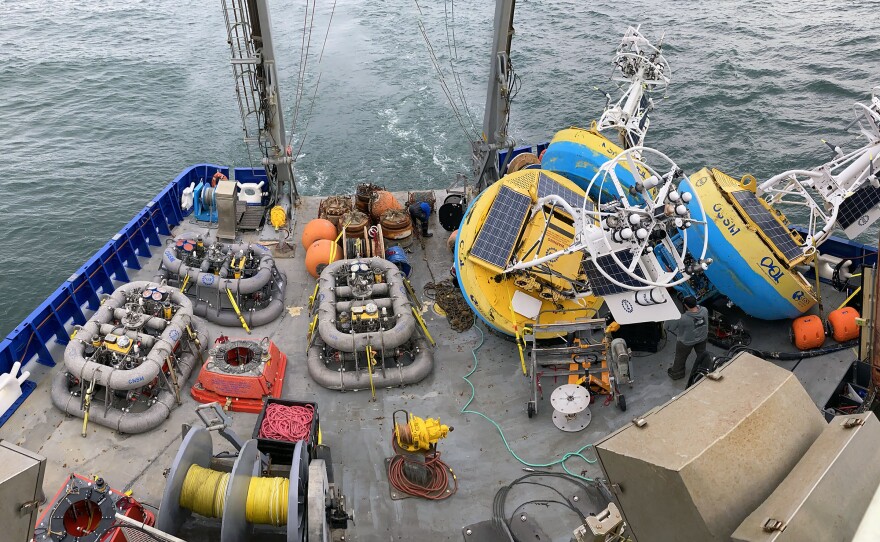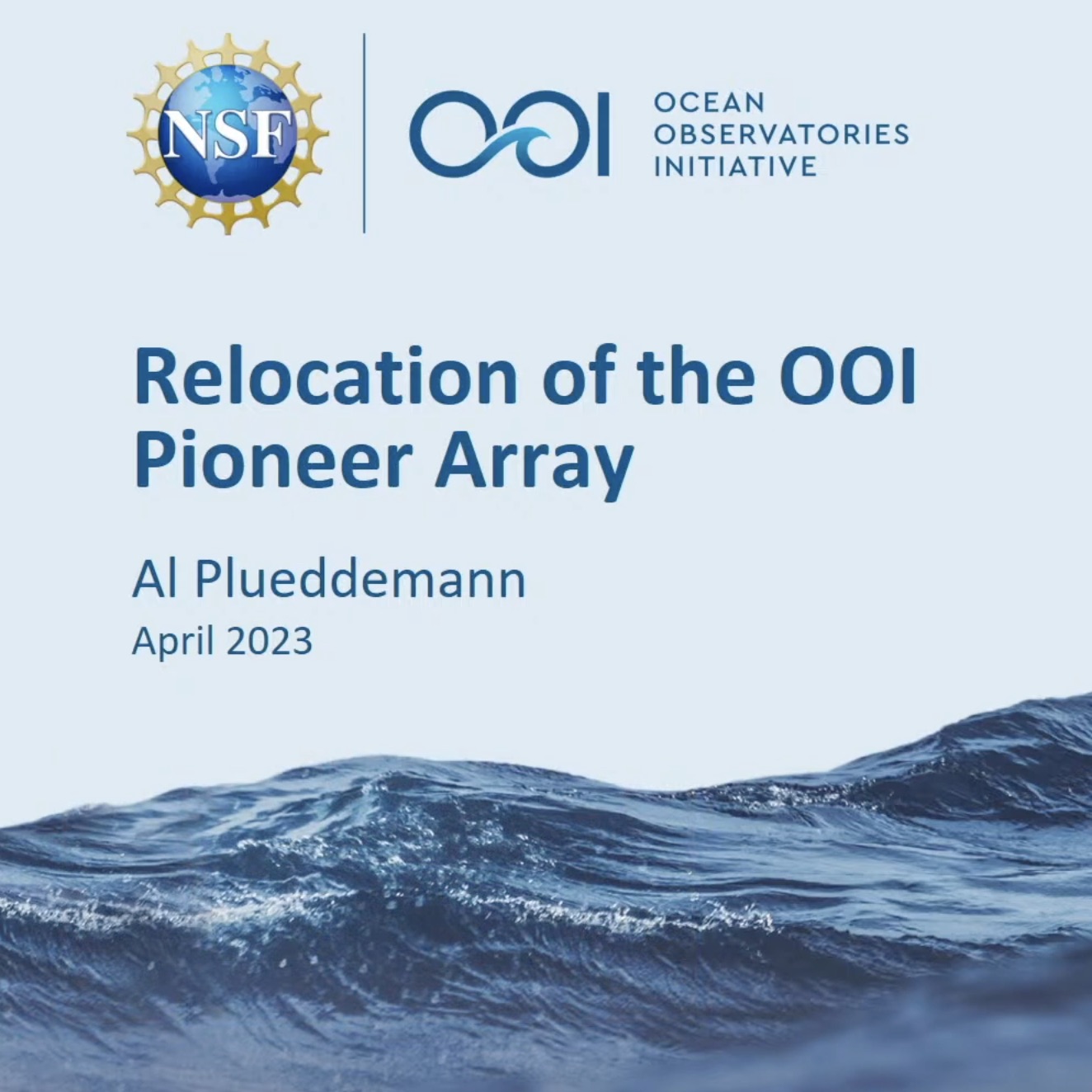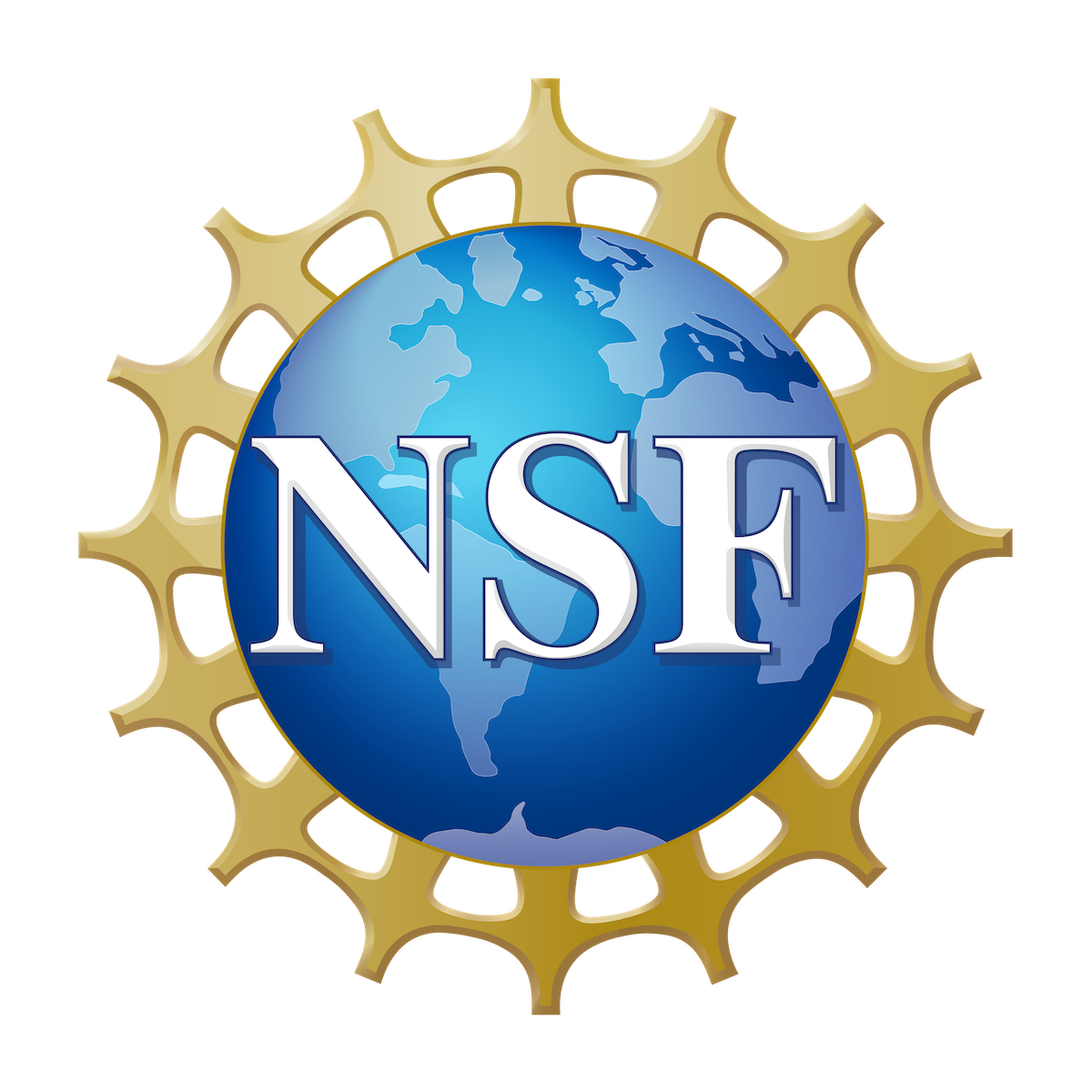Coastal Pioneer Array Relocation
The OOI Coastal Pioneer Array was commissioned in 2016 as a re-locatable coastal array suitable for moderate to high wind, wave and current regimes on the continental shelf and upper slope. The Coastal Pioneer Array was initially located off the coast of New England, about 75 nautical miles south of Martha’s Vineyard from 2016-the fall of 2022. The array consisted of cross-shelf moored arrays and autonomous vehicles. It was maintained by the Coastal and Global Scale Nodes (CGSN) team at Woods Hole Oceanographic Institution.
In early 2021, the National Science Foundation (NSF) and the Ocean Observatories Initiative Facilities Board (OOIFB) initiated a process to decide if, and if so where, the Pioneer Array might be relocated to answer pressing science questions and gather data from a new important region. To facilitate community input, NSF and the OOIFB held a two-phase series of unique workshops known as Innovations Labs. The Innovation Labs were held to solicit community input on where the Array might be located and how it might be configured.
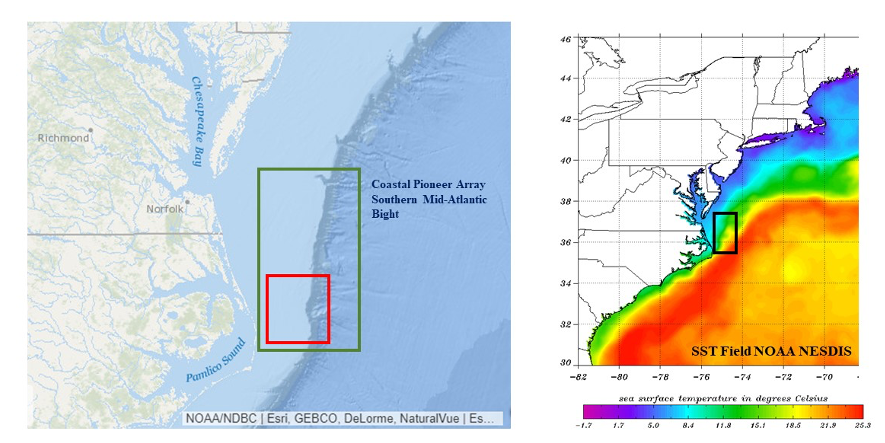
After consideration of input from the first Innovations Lab, held in April 2021, NSF proposed that the Southern Mid-Atlantic Bight between Cape Hatteras and Norfolk Canyon as the next location for the Pioneer Array (see Figure 1). The second Innovations Lab was held in June 2021 to help flesh out science questions, array configurations, and potential partnerships to help inform the planning for a successful relocation. The Mid-Atlantic Bight offers opportunities to collect data on a wide variety of cross-disciplinary science topics including the dynamics of cross-shelf exchange and Gulf Stream influences, processes driving biogeochemical cycling and transport, the ecosystem response to cycling and transport, and the impact of extreme events such as hurricanes and fresh-water outflows. The location also offers opportunities to improve our understanding of hurricane development, tracking, and prediction, and to form partnerships with the nascent offshore wind industry.
Since June 2021, members of the CGSN team at WHOI have been actively working on planning the relocation. The team launched a three-part process to plan for the array deployment at the proposed new location in 2024 as shown in Figure 2. Phase 1 was the planning phase (July 2021-April 2022), during which the team consolidated community input from the Innovations Labs and conducted site characterization and initial engineering assessments for the new site. The team also evaluated environmental regulatory requirements for the proposed new site in advance of submitting environmental compliance documents and permit applications.
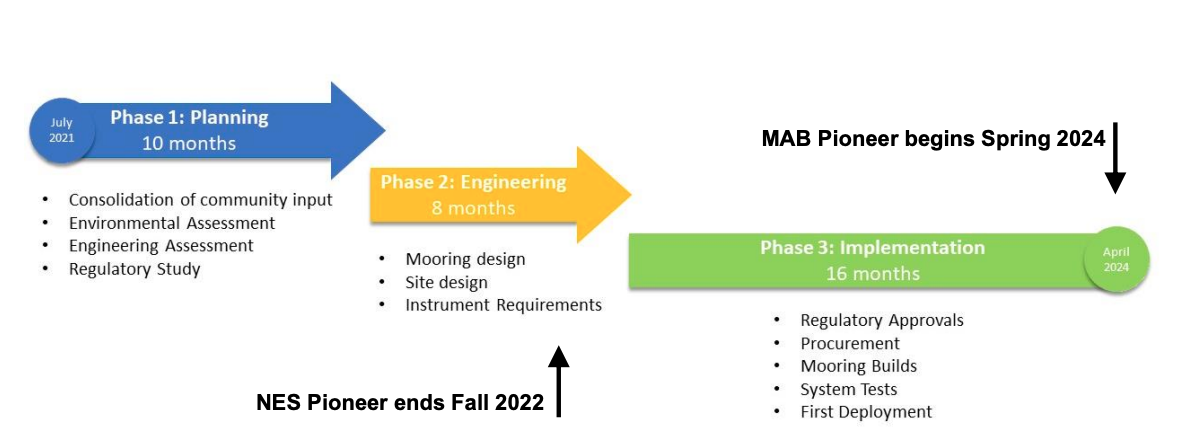
Phase 2, the engineering phase, ran from May 2022-December 2022. During this phase, the team completed engineering and design modifications for the moorings, developed instrumentation requirements, and finalized mobile asset plans. They also refined the site characterization and developed a procurement and build schedule. The operation of the New England Shelf Pioneer Array ended in November 2022 to provide time and funding for the redeployment effort.
The implementation stage, Phase 3, began in January 2023 and would end when the array is installed in its proposed new location, scheduled for April 2024. A great deal would be accomplished during this phase, including the successful initiation and conclusion of all environmental compliance (see more details below) and regulatory processes, procurement of materials and instruments, building and field testing of moorings, and ultimately preparation for, and execution of, a cruise to put the moorings in place in the new location.
Moving Forward: Test Deployments in Feb 2023
On Tuesday February 21, 2023, a team of scientists and engineers from WHOI left Charleston, SC aboard the R/V Neil Armstrong to begin test deployments in preparation for the installation of the Pioneer Array in its new location. The science team deployed two test moorings, occupying shallow and deep sites of the proposed array off the coast of North Carolina. The deployments are supplementing computer modeling to ensure the mooring designs perform as expected in the MAB environment.
The MAB location is expected to have different wind, wave, and current conditions than the Pioneer Array experienced on the New England Shelf. In addition, deployments in the new location will be in both shallower and deeper water depths than those off the New England coast. The preliminary moored array design is shown in Figure 2, with the two locations occupied by the test moorings highlighted.
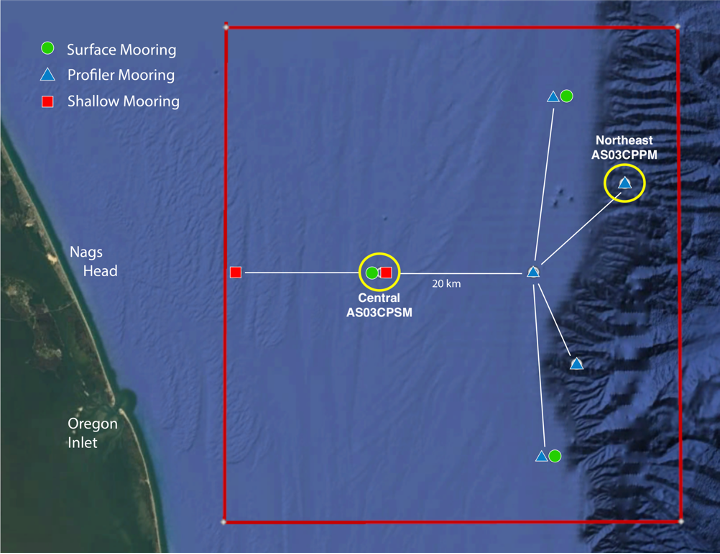
A Coastal Surface Mooring (CSM) was temporarily deployed at 30 meters depth at 35o 57.00’ N, 75o 07.5’ W. The CSM is specifically designed to examine coastal-scale phenomena and withstand the challenging conditions of shallow coastal environments. The Surface Mooring contains instruments attached to a Surface Buoy floating on the sea surface, a Near Surface Instrument Frame seven meters below the surface, and a Seafloor Multi-Function Node (MFN) located on the seafloor. Additionally, the Surface Buoy contains wind turbines and solar panels for power generation and antennas to transmit data to shore via satellite.Information gained from the test deployment will be taken into consideration into the overall array design and inform the environmental compliance process described below.
A Coastal Profiler Mooring (CPM) was temporarily deployed at 600 meters depth, 36o 03.80’ N, 74o 44.56’ W. The CPM contains a Wire-Following Profiler that houses instruments. The Wire-Following Profiler moves through the water column along the mooring riser, continuously sampling ocean characteristics from about 23 m below the surface to 23 m above the sea floor. The CPMs also carry an upward-looking Acoustic Doppler Current Profiler to measure ocean currents over the same region of the water column traversed by the profiler.
The test mooring data will be evaluated during the deployment and after recovery to determine whether any modifications would be needed to the mooring designs. . Like testing of the CSM, information gained from the test deployment of the CPM will be taken into consideration into the overall array design and inform the environmental compliance process described below.
Environmental Compliance
As described above, NSF proposes to relocate the OOI Pioneer Array to the Southern Mid-Atlantic Bight (MAB) in 2024 (Proposed Action). The Proposed Action would be funded by NSF and implemented through an existing Cooperative Agreement with Woods Hole Oceanographic Institution (WHOI).
On September 29, 2023, the National Science Foundation gave notice of the availability of the “Draft Supplemental Site-Specific Environmental Assessment for Pioneer Array Modifications and Relocation to the Mid-Atlantic Bight” (Draft SSSEA) for review and public comment.
The Draft SSSEA regarding the proposed action is posted for public comment on the NSF website, closing on October 28, 2023. NSF welcomes any comments you may have on the Draft SSSEA. Comments may be submitted via email to: nsfnepaooipioneer@nsf.gov. Comments received will be addressed in the Final SSSEA.

Planning Activities
December 18, 2023: Plans to Test New Wave Energy Power System
Plans to Test New Wave Energy Power System This video was produced by interns Andrea Galvan and Gabriel Fuentes on behalf of Sandia National Laboratories.
July 1, 2021: New Pioneer Array in the Southern Mid-Atlantic Bight Scoped
A very engaged group of participants spent the week of June 21st thinking about how to optimize the Pioneer Array for its relocation to the southern Mid-Atlantic Bight (MAB) in 2024. The five-day Phase 2 Innovations Lab, sponsored by the National Science Foundation (NSF), was led by the OOIFB (Ocean Observatories Initiative Facilities Board), a talented team of “Sparks”, Knowinnovation, Inc., and expertly supported by the OOI Facility. The group identified a range of representative interdisciplinary science questions that can be addressed using the Pioneer Array within the MAB and proposed optimum locations and potential configurations for the array.
Science question topics included air-sea interactions; the influence of estuarine plumes and the Gulf Stream on cross-shelf and shelf-slope exchanges and their impacts on ocean chemistry and biology; benthic-pelagic coupling; and canyon processes. Participants converged on a general region (see boxes in Figure 1 at right) that would best address the science questions.
“The Innovations Lab was very successful, and we really appreciate the community sharing their innovative ideas with us in this essential first step,” said Kendra Daly, chair of the OOIFB. “The Innovations Lab provides an excellent start to a long process of fleshing out the details to ensure that the array provides data to investigate a broad range of interdisciplinary science questions, while also being robust enough to weather the challenging environmental conditions in the Mid-Atlantic Bight.”
June 21-25, 2021: OOI Community Members Guide Pioneer Relocation
During the week, participants worked to identify the observatory opportunities that can be offered by the new Pioneer Array location. They explored how the Pioneer Array sensors and platforms can be optimized to achieve science and education goals at a new site, based on environmental, logistical, and infrastructural considerations. The group also evaluated challenges presented by deployment of Array infrastructure at a new location, and discussed the potential for partnerships and collaborations at a new site.
The MAB region offers opportunities to collect data on a wide variety of cross-disciplinary science topics including cross-shelf exchange, land-sea interactions associated with large estuarine systems, a highly productive ecosystem with major fisheries, and carbon cycle processes. This geographic region also offers opportunities to improve understanding of hurricane development, tracking and prediction, and offshore wind partnerships. The relocation of the Pioneer Array will take place in 2024.
The Ocean Observatories Initiative Facilities Board (OOIFB), in partnership with KnowInnovations, facilitated the Phase 2 Innovations Lab. “We selected a diverse mix of Lab participants to achieve a broad range of disciplines and professional expertise, career stage (from early to senior), gender, cultural background, and life experience. By involving such a wide range of people in the conversations this week, the innovative quality, outputs, and outcomes of the Lab were enriched,” said Kendra Daly, chair of the OOIFB. “And, throughout the year, we will continue to work with the community on the exciting optimization process via scientific meetings, seminars, and other means to ensure we receive broad input.”
May 31, 2021: Applications for the Pioneer Array Phase 2 Innovations Lab
Applications to apply for the Pioneer Array Phase 2 Innovations were due on May 31st. The Lab was held each day during the week of June 21-25 (about 5-6 hours each day). During this Lab, participants worked to identify the observatory opportunities that can be offered by the Pioneer Array at its new location at the Mid-Atlantic Bight. Application details are provided below.
The application form for the Pioneer Array Innovations Lab 2 was available here. Other details were provided here.
April 30, 2021: NSF Proposes Mid-Atlantic Bight for new Pioneer Array Location
As background, the OOI has been in full operations since 2016. The OOI Pioneer Array was designed to be relocatable, and in 2020 the Ocean Observatories Initiative Facilities Board (OOIFB) and the NSF launched a process to select the next OOI Pioneer Array location. A Phase 1 Innovations Lab was held in March 2021 to explore possible locations based on scientific questions of interest. The inputs received helped NSF make its decision to select the MAB.
A Phase 2 Innovations Lab is scheduled for the week of June 21-25. During this Lab, participants will work to further identify and refine the opportunities afforded by the new Pioneer Array location. Selected participants will be exploring how the Pioneer Array sensors and platforms can be optimized to achieve science and education goals at the new site, based on environmental, logistical, and infrastructural considerations. Partnership and collaboration potentials at the new location will also be discussed. The OOIFB, in partnership with Knowinnovations, Inc., will again be facilitating the Phase 2 Innovation Lab.
The ocean community was invited to help identify new design considerations that can enable exciting research endeavors at the chosen location. Scientists, educators, and other stakeholders were encouraged to apply for the Phase 2 Innovations Lab. An open-to-all Microlab was held May 12, 2021 for those interested in participating.
March 15-19 2021: Phase 1 Innovations Lab Considers Pioneer Array Location
In 2021, the Ocean Observatories Initiative Facilities Board (OOIFB) and the National Science Foundation (NSF) launched a process to consider whether to move the Pioneer Array from its current location, on the New England shelf and slope south of Martha’s Vineyard, to a new site. Selection of the next OOI Pioneer Array location, or decision to maintain the Array at its current location, was to be driven by community input on the important science questions that can be addressed by the Pioneer Array.
The OOI community was invited to weigh in on this important decision during a two-phase sequential lab approach that brought together scientists, educators, and other stakeholders together virtually to evaluate 1) future location options for the Pioneer Array and 2) new design considerations that can enable exciting research endeavors at the chosen location.
The Phase 1 Innovations Lab was held on March 15-19to explore possible locations for the Pioneer Array based on multiple factors, driven by scientific questions that require an ocean observatory to advance knowledge. At the Lab, interdisciplinary teams worked together to ideate and develop a roadmap of possible locations including exploring new scientific, educational, and partnership opportunities. Participation was open to the all, and 32 applicants were selected to participate in this important decision.
The Lab’s findings were considered by an NSF review panel, which will report to NSF in early fall on the new Pioneer Array location and how it can be optimized for science and education. The findings of both Innovations Lab will be shared with the OOI community.
Jan 13, 2021: Questions about Potential Pioneer Array Move Answered
On Wednesday 13 January, 2021, the National Science Foundation and the Ocean Observatories Initiative Facilities Board held a microlab to answer questions about the process for deciding if, and if so, where, the Pioneer Array might be relocated. The microlab was designed to provide potential applicants with information about the selection process as well as technical details about the Pioneer Array to be considered for potential new locations.
All feasible location options were to be considered – new geographic areas, as well as maintaining the Pioneer Array in its current location – during a two-phased Innovation Labs, which all were invited to apply to participate. Selection of a new OOI Pioneer Array location was to be driven by community input on the important science questions that could be addressed with observations from a new Array location.
The answers to the questions posed during the microlab can be found here.

